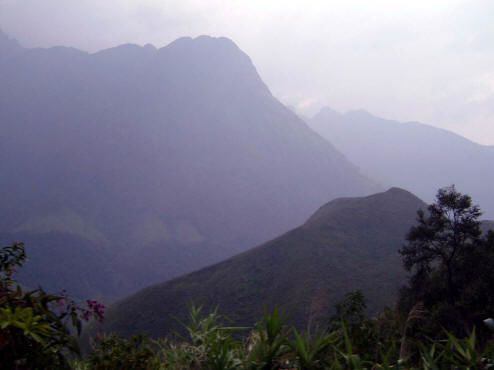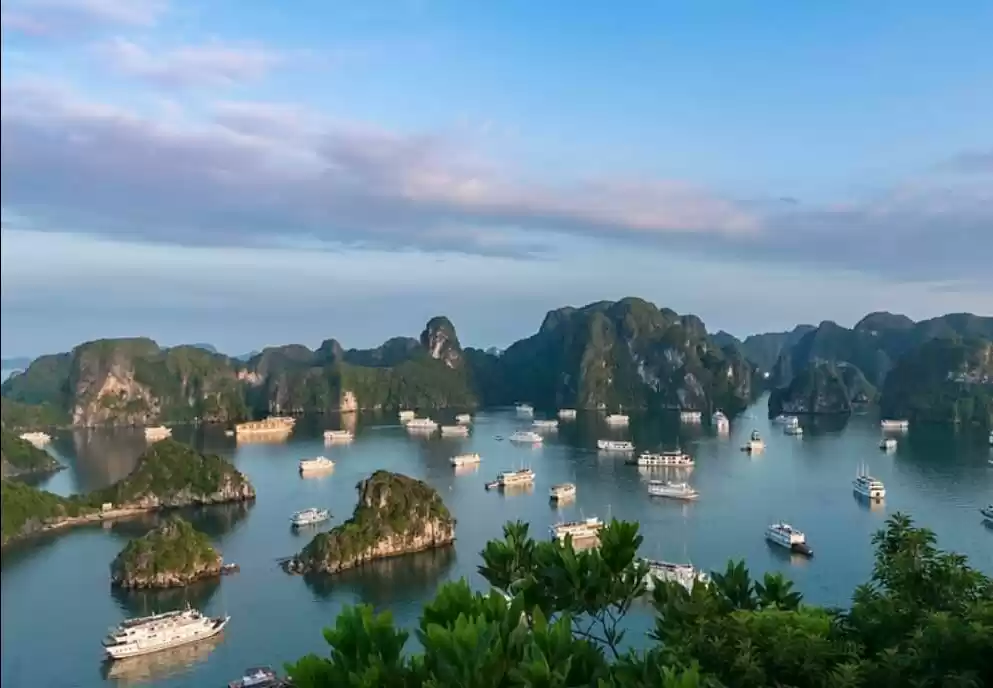









When landing in Hanoi, Vietnam's capital city, it was as if the tape of our lives was suddenly switched to fast forward. Beep, honk, beep! This never-sleeping city keeps you on your toes, as thousands of 'moto' bike drivers get you in their sites and barely avoid hitting you while crossing a street. Like Indiana Jones on his last crusade, you have to just step out into the void, knowing that you will get caught up in the flow and burped out on the other side. Vietnam has a rich, intriguing history. This diversity is linked with the many wars and occupations by the Chinese, Khmers, Chams, Mongols, French and Americans, to name a few. This vibrant nation should never be underestimated. Always getting out from under conflicts these strong people are once again struggling to make their way in the world.
Having bought a six-month Vietnamese visa in Laos we had a lot of time to explore this fascinating country. Taking the slow, arduous route around northwest Vietnam found us staying in Son La, Dien Bien Phu, and Tam Duong. All these towns are connected by miles of winding, bumpy roads meandering through scenic mountain landscapes. Exploring Vietnam is fruitless without meeting and spending some time with the locals. Nothing teaches you more about the culture. Most foreigners think that Vietnam's culture is in some remote village. A mistake. The simplest way to have a great experience with the locals is to visit the markets. Catch the local bus there and share experiences like bargaining for vegetables or buying supplies elbow to elbow at the many stalls. Do what the locals do.
We admit that Vietnam may be a challenge at times for the faint of heart or the thin-skinned traveler, but don't listen to any disgruntled reports of this stimulating country. Spend some time with remote country folk before passing a verdict. As the Aboriginals of Australia say, "Observe and Allow." Go past the tourist-weary touts and find the smiles hidden around every corner.
Our journey through Vietnam lasted for around five months. To make it easier for you to read about everything we did there, we have split it into two parts.
Wandering through the haven of the many lakeside parks and side streets with descriptive names like Chan Cam - string instruments, Hang Dao - silk dyers, Hang Mam - pickled fish, Hang Ruoi - clam worms, Lo Su - coffins, or Thuoc Bac - herbal medicine, is a fun way to explore Hanoi. This once elegant city, with sites such as the Confucius Literature Temple (founded in 1070A.D. - 30 years before Paris was incorporated) or the ancient art of Water Puppetry, was barely visible through the haze. Hanoi is a very busy city, with streets overflowing with vehicles and traffic. The city has a lot to offer, but take a big, deep breath of clean air before you arrive.

In Sa Pa, we were lucky to find a wonderful room overlooking Mt. Fansipan, 3143m., the highest in Vietnam. It was a bit misty outside our window, but we could still see glimpses of the steep rice terraces that are characteristic of Sa Pa. The weather wasn't our best friend here with downpours greeting us and making travel tedious. Still, the warmth and friendliness of the local ethnic villagers and the colorful market made up for the cool, misty weather. We were lucky to have encountered the Autumn Lights Festival, which brought out so many colors and a whole lot of joy in the streets. There is a rare combination of old and new in Sa Pa as the new infrastructure provides good restaurants and hotels while the tribes people from surrounding villages hang around trying to sell their handicrafts.

At Bac Ha, we interacted with the locals by visiting their very vibrant Sunday market. Completely different ethnic groups were represented, with the colorful Flowery Hmong being the most numerous. This incredible market was a flurry of activity as the tribes people from the surrounding villages walked or rode horse-carts to buy or sell goods and catch up on the latest hilltop gossip. Later, we walked on the unpaved roads to a few neighboring villages and met various locals, who were warm and welcoming. A few invited us inside their houses for some tea.

At Can Cau, we met various brightly colored Flowery Hmong women bustling about in the mountain-top market. Their outfits are exquisitely embroidered, with layer after layer of hand work making the full skirt and matching top one of the most elaborate we have seen. We walked around the village for a while before heading back to Bac Ha.

The road to Bao Lam from Ho Giang was simply spectacular, winding its way along the Lu River valley, with lush green rice fields and thatched huts, amid looming peaks and canyon walls. We started our day with "Good Morning Vietnam" on Radio Vietnam and headed to the weekly market. Bao Lam is definitely off the tourist route. Not even in the Lonely Planet or on the map, and with no real infrastructure, we felt that our pleasant encounters with these wonderful locals were almost "first contacts". It was an enjoyable experience for both parties as we laughed our way through the large market, women proudly posing and displaying their elaborate, colorful costumes and hats, then squealing with delight to see themselves on camera for the first time. A new town always has to be explored and that we did. We followed many dirt roads to surrounding villages or along the river and a dirt path zigzagging 2000 ft. straight up the mountains. Our favorite walk was east out of town, across the foot-suspension bridge, then heading up the valley on the high path. We were invited into several thatched huts so poor that we only ate a couple of the small taro type roasted potatoes offered to us. We continued to follow a riverbed that turned into a magnificent waterfall.

A 90 minute ride from Cao Bang, Trung Khanh, home of the spectacular Ban Gioc Waterfalls, passes through one pleasant little stone village to the next, like pearls on the bluish-green string of water from the river in the valley. The falls aren't disappointing, even in the dry season and it was fun for us to wave at the Chinese tourists enjoying the view from the other side. Totally undeveloped on the Vietnamese side, the Chinese side had a hotel and a gaggle of tourists walking in pods or riding horses. To explore the area a bit, we followed the lazy, milky-green river complete with scores of bamboo waterwheels. The gorgeous river drew us in and we stopped to make our vegetable salad and soaked our feet amid the clusters of bamboo, mini waterfalls and interesting rock formations. We spent several days wandering rural paths and exploring villages. The villagers were always friendly, but we were careful to have a stick for overly protective dogs.

This tropical rainforest has over 600 plant species, 70 mammals, and 200 birds, butterflies and other insects. The stunning lake and forest scenery make up for the strange organized accommodations far from the water. We, luckily, were dropped off by our minibus at a junction across the bridge, on the other side of the lake. We spent a leisurely couple of days exploring the forests and shoreline of Ba Be Lake and drinking tea with the family while surveying the sweeping lake views. We cooked over a wood fire in the corner of the kitchen, carefully tip toeing across the thin but strong split bamboo floors.

It takes at least 45 km. to leave behind the haze of Hanoi and greet the ocean breezes of Halong Bay. We luxuriously filled our lungs with the fresh sea air. We had been away from the ocean for too long. The further we sailed from the coast the slower the pace got and four hours later we landed on remote Quan Lan Island. We explored the end of the island opposite the ferry pier, past women digging clams and men breaking up road rock by hand. Continuing on for miles to the end of the road we happened on a couple of tiny remote villages. A leisurely walk amongst the fields, through the family cemetery, and along the beach is an interesting way to catch everyone in action on Quan Lan; tending the crops, collecting seafood along the shore, and making brooms or large briquettes from the coal-tar in nearby Cua Ong. The genuine friendliness and laid-back ambience of this quiet island makes it a must-visit for anyone with some extra time.

The best way to get to Cat Ba is via a tour of the islands. The zoo at the dock for overnight tours was discouraging, but once on the boat the scenery was spectacular. Halong Bay has a unique ecosystem with 3000 islands, (and as many tourists on the weekend), but it is still able to absorb the tour groups without feeling crowded. Designated a World Heritage Site, the eastern side of this famous bay is completely untouched and we were glad that some things remained the same. Far from being washed up on a deserted island, Cat BA, is a 'wanna be tourist destination' and the infrastructure is expanding to meet the growing need. Besides trekking in the National Park, it is best to climb up the various hills surrounding the bay. A pleasant four mile hike is following the road to the bay at Cat Hai and back around down the hill into Cat Ba Town's main market - where fresh, hot, sweet corn and refreshing coconuts are waiting as a reward. A definite highlight of our stay was an hour's paddle around the bay in Liu's woven basket-type row-boat. The bay is bustling with fishing and house boats of all sizes, and the floating markets servicing them.

The cold winds of the first snow in China had blown us down south - quick - and sauntering along the Perfume River en route to the Citadel, in laid-back Hue on a warm sunny afternoon, confirmed we had made the right choice. A pleasant day on the river found us exploring the seven storied, octagonal Thien Mu Pagoda (1601AD), Hon Chen Temple and the stunning, serene Minh Mang Tomb, with its forests and lakes. On a superlative day we saw the largest bell in Vietnam, cast in 1710AD, which can be heard 10 km. away and the massive 20 ton stele lauding the accomplishments of ruler Tu Duc, the author non other than Tu Duc.

We explored the shops, villages, and ancient Chinese and Vietnamese Temples along the Thu Bon River. From a lively vegetable market to in-vogue French bakeries and restaurants, this town is a fun place to relax for a few days. The earliest evidence of human habitation in Hoi An dates back to over 2200 years ago. From the 2nd to 10th centuries, this was the center of the Kingdom of Champa. An interesting way to look at this ancient Champa civilization is to take the inexpensive tour to My Son, passing through the countryside and up into the mountainous jungle where the ruins are located. Catch the seductive Shiva/Kali dance near the first ruin and opt for the boat trip back to Hoi An, stopping to see woodcarvers and boat builders along the way.

Frequent Searches Leading To This Page:-
Vietnam Tour Places, Vietnam 4N 5D Itinerary, Vietnam Tourism Office In India, Vietnam Tour Operators In Vietnam, Delhi To Vietnam Flight, Places To Visit In Vietnam





























